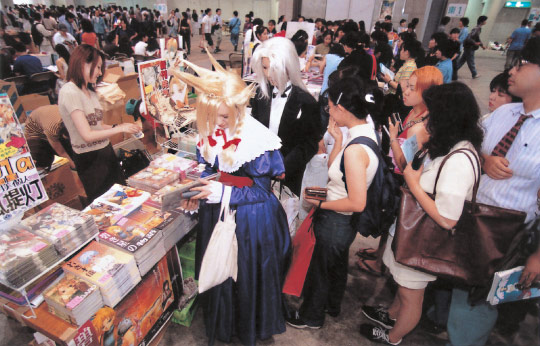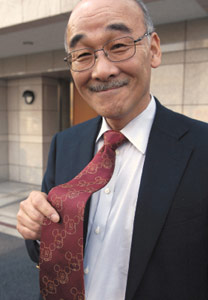Special Feature![]() The Cute World of Kawaii
The Cute World of Kawaii
Geeks and kawaii
Kanno: Many of the latest cute styles seem to have been inspired by that group of people we call otaku 7 (geeks).
Obata: Products began exhibiting a cute side in the 1980s, but by the 1990s manufacturers were running out of ideas. That's when consumers started taking their cue from geeks.
Ishihara: Yes, but some things developed a cuteness of their own, and then were given the cute label by geeks and accepted as such by the general population. One example could be cosplay role players, dressing up as Sailor Moon.

Left: In 1992, Bishoujo Senshi Sailor Moon became a hit after appearing simultaneously in a magazine series and an animé.
Right: A two-woman team enjoying cosplay ("costume play," or dressing up as pop media characters) in Tokyo's Akihabara district. (Photo: Nose Hirofumi)
Kanno: Geeks might label something as cute, and an ordinary person might find it cute as well, without being influenced by them. It could be the geeks just give it the label.
Ishihara: Don't you get the impression that magazines for elementary school students cover geek culture a lot?
Kanno: Yes, they do. Geeks go in for cute things like figurines, and when magazines for elementary school kids include figurines as a bonus, many adults will buy the magazines in order to get the figurines, boosting sales enormously. I suppose they find out about them online.
Obata: Adults also buy lots of Morning Musume8 items.
Ishihara: It's interesting that geeks don't use the word "kawaii " when talking about things they find cute.
Kanno: No, they say "moe~." 9 That word has been around for the last two or three years. It expresses a sudden feeling of appreciation welling up from within.
Ishihara: Yes, moe comes from moe-izuru, which makes one think of a seed sprouting, rising up from the ground.
Kanno: Yes, one's feelings of admiration "sprout" like that.
Obata: I suppose there are different explanations for the term, but when a geek says "moe~" the meaning is basically the same as the more common "kawaii! "

How cute is kawaii ?
Another Key to Harmony
By Ishihara Soichiro, columnist Photo by Kono Toshihiko
Japanese adults find kawaii a very useful word today. If we were not allowed to use it, we would be badly inconvenienced.
There are times when an adult has to say something good about something, even when it is, for example, the garish necktie our boss is wearing for the first time, or a hideous pair of curtains a friend just put up. We can't bring ourselves to say, "Hey, that's really nice" or "You've got a good eye for style." But we can be positive, and non-committal at the same time, by saying "kawaii " to indicate quite simply that we think it is cute. If, for example, your fellow worker or lover gives a little shriek when surprised, he/she may feel embarrassed, so that's a good time to tell them they are being kawaii.
Kawaii is a good word for different situations because it has shades of meaning. You can remain vague about your aesthetic values while still showing you empathize with the person and wish them well. Japanese adults put the highest priority on trying to make things go smoothly, and the word "kawaii " is an excellent instrument for this purpose.
And of course there are benefits for the person who is told he or she is kawaii. In Japan, young women often tell their boss and middle-aged men that their appearance, gestures or possessions are kawaii. The word itself, if you think about it, is hardly a compliment, but nobody would think that or get angry. When you say "kawaii," you are not really expressing an opinion at all, just a feeling of empathy and caring. Human relationships benefit, without anyone feeling the need to express disagreement or agreement.
I suppose we Japanese adults will continue to use kawaii to maintain harmony in human relations. The word may seem strange, even irritating, but I hope you can see its benefits, and perhaps even think that the word itself is cute.
